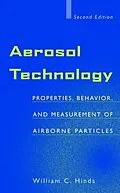The #1 guide to aerosol science and technology -now better than ever
Since 1982, Aerosol Technology has been the text of choice among students and professionals who need to acquire a thorough working knowledge of modern aerosol theory and applications. Now revised to reflect the considerable advances that have been made over the past seventeen years across a broad spectrum of aerosol-related application areas - from occupational hygiene and biomedical technology to microelectronics and pollution control -this new edition includes:
* A chapter on bioaerosols
* New sections on resuspension, transport losses, respiratory deposition models, and fractal characterization of particles
* Expanded coverage of atmospheric aerosols, including background aerosols and urban aerosols
* A section on the impact of aerosols on global warming and ozone depletion.
Aerosol Technology, Second Edition also features dozens of new, fully worked examples drawn from a wide range of industrial and research settings, plus new chapter-end practice problems to help readers master the material quickly.
Autorentext
WILLIAM C. HINDS, PhD, is a professor in the Department of Environmental Health Sciences at the UCLA School of Public Health. His primary research interest is fundamental and applied research related to aerosols and industrial control of airborne contaminants, including respiratory protection. A Diplomate of the American Board of Industrial Hygiene (comprehensive practice) and a Fellow of the American Industrial Hygiene Association, he has published numerous articles on aerosols.
Zusammenfassung
The #1 guide to aerosol science and technology -now better than ever
Since 1982, Aerosol Technology has been the text of choice among students and professionals who need to acquire a thorough working knowledge of modern aerosol theory and applications. Now revised to reflect the considerable advances that have been made over the past seventeen years across a broad spectrum of aerosol-related application areas - from occupational hygiene and biomedical technology to microelectronics and pollution control -this new edition includes:
* A chapter on bioaerosols
* New sections on resuspension, transport losses, respiratory deposition models, and fractal characterization of particles
* Expanded coverage of atmospheric aerosols, including background aerosols and urban aerosols
* A section on the impact of aerosols on global warming and ozone depletion.
Aerosol Technology, Second Edition also features dozens of new, fully worked examples drawn from a wide range of industrial and research settings, plus new chapter-end practice problems to help readers master the material quickly.
Inhalt
Preface to the First Edition xi
Preface to the Second Edition xiii
List of Principal Symbols xv
1 Introduction 1
1.1 Definitions 3
1.2 Particle Size, Shape, and Density 8
1.3 Aerosol Concentration 10
Problems 12
References 13
2 Properties of Gases 15
2.1 Kinetic Theory of Gases 15
2.2 Molecular Velocity 18
2.3 Mean Free Path 21
2.4 Other Properties 23
2.5 Reynolds Number 27
2.6 Measurement of Velocity, Flow Rate, and Pressure 31
Problems 39
References 41
3 Uniform Particle Motion 42
3.1 Newton's Resistance Law 42
3.2 Stokes's Law 44
3.3 Settling Velocity and Mechanical Mobility 46
3.4 Slip Correction Factor 48
3.5 Nonspherical Particles 51
3.6 Aerodynamic Diameter 53
3.7 Settling at High Reynolds Numbers 55
3.8 Stirred Settling 62
3.9 Instruments That Rely on Settling Velocity 65
3.10 Appendix: Derivation of Stokes's Law 67
Problems 70
References 73
4. Particle Size Statistics 75
4.1 Properties of Size Distributions 75
4.2 Moment Averages 82
4.3 Moment Distributions 84
4.4 The Lognormal Distribution 90
4.5 Log-Probability Graphs 94
4.6 The Hatch-Choate Conversion Equations 97
4.7 Statistical Accuracy 100
4.8 Appendix 1: Distributions Applied to Particle Size 104
4.9 Appendix 2: Theoretical Basis for Aerosol Particle Size Distributions 105
4.10 Appendix 3: Derivation of the Hatch-Choate Equations 105
Problems 108
References 110
5. Straight-Line Acceleration and Curvilinear Particle Motion 111
5.1 Relaxation Time 111
5.2 Straight-Line Particle Acceleration 112
5.3 Stopping Distance 117
5.4 Curvilinear Motion and Stokes Number 119
5.5 Inertial Impaction 121
5.6 Cascade Impactors 128
5.7 Virtual Impactors 134
5.8 Time-of-Flight Instruments 136
Problems 138
References 140
6. Adhesion of Particles 141
6.1 Adhesive Forces 141
6.2 Detachment of Particles 144
6.3 Resuspension 145
6.4 Particle Bounce 146
Problems 147
References 148
7 Brownian Motion and Diffusion 150
7.1 Diffusion Coefficient 150
7.2 Particle Mean Free Path 154
7.3 Brownian Displacement 156
7.4 Deposition by Diffusion 160
7.5 Diffusion Batteries 165
Problems 168
References 169
8 Thermal and Radiometrie Forces 171
8.1 Thermophoresis 171
8.2 Thermal Precipitators 176
8.3 Radiometrie and Concentration Gradiant Forces 178
Problems 180
References 180
9 Filtration 182
9.1 Macroscopic Properties of Filters 182
9.2 Single-Fiber Efficiency 190
9.3 Deposition Mechanisms 191
9.4 Filter Efficiency 196
9.5 Pressure Drop 200
9.6 Membrane Filters 202
Problems 204
References 204
10 Sampling and Measurement of Concentration 206
10.1 Isokinetic Sampling 206
10.2 Sampling from Still Air 213
10.3 Transport Losses 216
10.4 Measurement of Mass Concentration 217
10.5 Direct-Reading Instruments 222
10.6 Measurement of Number Concentration 225
10.7 Sampling Pumps 228
Problems 230
References 231
11 Respiratory Deposition 233
11.1 The Respiratory System 233
11.2 Deposition 235
11.3 Deposition Models 242
11.4 Inhalab...
